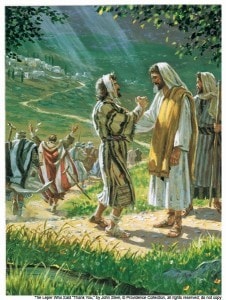Don’t forget about the Gratitude Challenge! The linky will go up tomorrow but it will stay open until Thanksgiving. Choose a random day to document either through photos or words all you are thankful for that day. Enjoy this guest post by Nancy on teaching children.
One of my favorite scripture stories is the story of Jesus healing the ten lepers in Luke chapter 17. Jesus healed ten lepers, but only one gave thanks:
“And one of them, when he saw that he was healed, turned back, and with a loud voice glorified God,
“And fell down on his face at his feet, giving him thanks:”
When I ponder on these verses I think of gratitude, but I also think of manners. Only one of the lepers returned to give thanks. It is possible that the others felt grateful to be healed, but only one remembered his manners. I think that manners are an outward expression of gratitude.
William Shakespeare said, “How sharper than a serpent’s tooth it is to have a thankless child.” When children do not display good manners they appear “thankless” and ungrateful. I am sure we all constantly are reminding our children with clichés like, “What do you say?” urging them to say thank you or “What are the magic words?” for a please. However, it is important to also help them understand why we say these words. There are many ways to teach children gratitude, but lately my mind has been on how to help children express their gratitude through manners. I want my children to understand the importance of not only feeling grateful, but expressing it. Here are a few ideas we have used with our children.
In the home
Home is often the place that we forget our manners most and often we forget to be grateful for our own family members and the things they do for us.
Saying “thank you” in itself is an expression of gratitude. Since I am due to have a baby in a few weeks I have found myself asking for a lot of help from my other children: to pick things up off of the floor for me, to put my toddler in her high chair, to dress her, change her diaper, and even catch her for me when she runs away. I am very grateful for their help, but if I don’t remember to say thank you to them then I am not showing good manners, nor am I expressing outwardly my gratitude. Modeling good manners is extremely important in helping children understand the difference manners make in the home environment.
At mealtimes my husband is very good at thanking me for food I prepare and after he thanks me the children usually chime in with their thanks as well. There are days when the food doesn’t taste very good. When we have a child outwardly express disgust for the food and say things like “Yuck,” “I hate this food” or “This tastes gross,” it is time for a little gratitude lesson. I think we as moms are often resilient to these comments by our children, but are they mannerly? Would we allow our children to say such comments to anyone else serving them food? I know I would feel embarrassed if my children said such things to a grandparent or at a friend’s house. When my children act this way I always bring up the Golden Rule and ask them how they would feel if they worked hard to make a meal for somebody and that person yelled “Yuck!” We talk about being grateful for people who serve us and for food to eat even if we don’t like it. Then we talk about eating a tiny portion of food we don’t like or politely stating that we cannot eat a certain food. (We have a daughter with a severe peanut allergy and so we have to maintain a peanut-free house. As a result this has really come in handy when we are offered food containing peanuts from others.)
Children often receive presents from relatives and teachers. I think most children are very grateful for presents, but how many express that feeling in more ways than a quick thanks? I think many times children do not know how to express the thankfulness they feel, but when we guide them using manners they are able to display their gratitude. Thank you cards are high up on the list of showing good manners. Just last week a Primary teacher brought over a gift for one of my daughters. During the week I noticed that my daughter drew a picture for her teacher on a lined piece of paper that she ripped out of a spiral notebook (with all those little papers on the side). Then she wrote a little letter to her teacher. At first I had an urge to ask her to redo it in a blank card and to fix a few spelling errors so that it would look like a traditional thank you card. However, I stopped myself and let her present the thank you card that came from her own grateful heart. I am so glad I did because her teacher just treasured it and it was obvious that it was her own doing and not a dictated letter from Mom.
Away from Home
After church on Sundays I always ask each of my children about what they learned in Primary (Sunday school) and also I ask them how they behaved in class. We have had many discussions on being grateful for our teachers, leaders, and our church building. If my children tell me of instances when their class at church did not behave I ask them how they think their teacher felt. We talk about how their teacher probably took much time and effort to prepare a lesson. Then I ask my children how they can show that they are grateful for the teacher’s work and service for them. The answers are always about showing manners: sitting reverently, raising hands, not interrupting, and not showing other rude behavior. We talk about not running in the halls or throwing trash on the ground at church as a way to show gratitude for our church building. Teaching children to say thank you to their teachers and also to offer their help carrying things, cleaning up, or stacking up chairs after class also help children to feel and show more gratitude.
My children are homeschooled, but the same principles apply for children who go to school or to any other activities such as Scouts, church activities, and extracurricular activities.
In our Prayers
Although I have prayers last on my list I believe it is the most important way to express gratitude. Just as we should show manners and thank each other, we should do the same to our Heavenly Father who has given us all that we have. We teach our children to say a prayer over each meal to give thanks for the food. We are really working on teaching them to wait to eat until after the prayer (not before or during which they seem inclined to do). We say prayers as a family to express gratitude for our blessings and we teach our children to consider their blessings and express thank personally to Heavenly Father for all he has given them.
Manners help us walk with “an attitude of gratitude” as President Thomas S. Monson has urged us to do. When we remember to be polite, kind, and full of thanksgiving we are much more aware of our daily blessings.
Nancy Rivera is a wife and mother of five (almost 6 – just 1 more month!). She homeschools her children. She served a mission in Osorno Chile where she developed a love of the Spanish language. She now spends a lot of time trying to make her kids bilingual. She grew up in Southern California and now lives in Oregon. She blogs at http://losindustriosos.blogspot.com/




Such a great reminder. This is definitely one of those things that are easy to just assume a child will figure out — gratitude; but how silly to just assume. Why not be teaching them and pointing it out to them. Thanks!